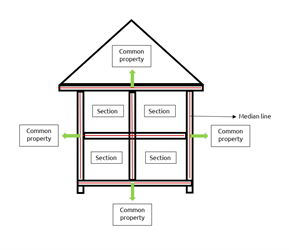Your guide to maintenance and repairs in sectional title schemes
Part 1 | Shared Spaces, Shared Costs
22 November 2024 | Fausto di Palma and Suzanne de Villiers
In the well-known Home Box Office (HBO) series, Game of Thrones, and the related novels by George R.R. Martin, characters Jon Snow and Maester Aemon often speak about the Wall’s importance in protecting all of Westeros. The Wall is not just the responsibility of the Night’s Watch; it protects the entire realm.
Just like the Wall in the North that safeguards all of Westeros, the upkeep of shared spaces in sectional title schemes is essential for the benefit of the entire community. Everyone, from owners to the body corporate itself, has a role to play in maintaining these spaces for the common good.
Buying a property can be both an exciting and nerve-racking experience for any prospective owner, especially first-time buyers. For most people, this will be one of the biggest single investments they will make within their lifetime.
When buyers purchase a unit within a sectional title scheme, it often comes with amenities, which can include items such as 24-hour security, swimming pools, shared gardens, and other recreational areas, as well as solar and battery storage facilities.
Owners are often unaware of who is responsible for the maintenance and repair costs for a particular item should something go wrong, which we aim to clarify in this article series.
1. Important legislation
Firstly, it is important to note the legislation that governs sectional title schemes within South Africa and that will be referenced in this article. This legislation includes the following:
The Sectional Titles Act 95 of 1986 (“STA”) and the Regulations thereto;
The Sectional Titles Schemes Management Act 8 of 2011 (“STSMA”) and the Regulations thereto;
The Prescribed Management Rules (“PMR”) of Annexure 1 the STSMA Regulations;
The Prescribed Conduct Rules (“PCR”) of Annexure 2 the STSMA Regulations; and
The Community Schemes Ombud Service Act 9 of 2011 (“CSOS Act”) and the Regulations thereto.
2. Maintenance and repair: Who is responsible
Secondly, before one looks at specific items and the question of who is responsible for the costs of maintenance and repair, one needs to understand how this legislation may apply to the different parts of a sectional title scheme.
These parts of the sectional title scheme include the following:
Primary Sections
Defined in Regulation 1 of the STSMA Regulations.
Intended for human occupation, i.e. residential or commercial use.
Examples: a residence, office, shop, factory or for any other type of use allowed in terms of local municipal by-laws.
Utility Sections
Defined in Regulation 1 of the STSMA Regulations.
In terms of local municipal by-laws, designed to be used as an accessory to a primary section.
Examples: a parking garage or a storeroom.
Common Property
Defined in section 1 of the STA and STSMA.
Consists of all land and the buildings, or part thereof, in the scheme which are not primary or utility sections.
Collectively owned by all unit owners in undivided shares, with each owner's share corresponding to the size of their respective section.
Exclusive Use Areas (“EUAs”)
Defined in section 1 of STA and STSMA.
EUAs are portions of the common property set aside for the exclusive use of one or more unit owners or occupiers.
The holders of exclusive use rights typically have the sole right to use and enjoy a specific portion of the common property. This right allows the holder to occupy and use that specific area, such as a garden, yard, or parking space, without interference from other unit owners or occupiers.
3. Understanding boundaries
Thirdly, it is also important to have a clear understanding of the boundaries between a section (either a primary or utility section), other sections and common property, which the STA refers to as the median line.
This understanding is necessary, as it usually depends on where the median line is located in relation to the section’s boundaries with reference to the necessary work that is required when it comes to determining responsibility for maintenance and related expenses.
What is a median line?
Section 5(4) of the STA specifically refers to the median line as:
“The common boundary between any section and another section or common property shall be the median line of the dividing floor, wall or ceiling, as the case may be.”
In other words when two sections share a boundary, or when a section shares a boundary with any portion of the common property, the median line is considered to be the middle line between the floor, wall, or ceiling that separates these areas.
It may be simple to determine the median line between sections and common property by applying the above principle to the sectional plan (required to be prepared in terms of sections 4 and 5 of the STA), however, confusion often arises when considering items such as windows, doors and balconies which is discussed further below.
If you would like to find out more information where there are any uncertainties as to responsibility, we suggest reaching out to community schemes experts, TVDM Consultants at 061 536 3138 or info@tvdmconsultants.com. For funding solutions that can assist a scheme to financially undertake any repairs or upgrades, please reach out to Sectional Title Solutions at 010 020 8200 or info@stsolutions.co.za.
While this article offers general guidance, it is crucial to understand that specific circumstances can significantly influence responsibility and liability within schemes. In complex or ambiguous situations, we strongly recommend reaching out to our advisory desk for tailored assistance.
Contextual factors often play a pivotal role in determining who bears the costs or responsibilities in any given scenario, and the principles discussed here, while broadly applicable, may not cover every unique case. Individual circumstances may lead to different outcomes, so personalised advice is essential for navigating these complexities effectively and reaching a fair and accurate outcome.
About the Authors:
Fausto Di Palma, BCOM LLB, Rhodes University, Chief Legal Officer of Sectional Title Solutions (Pty) Ltd. Fausto heads up the STS Group’s Legal Team and carries a wealth of knowledge and experience concerning community scheme and property legislation and case law.
Suzanne de Villiers, LLB, UKZN, Admitted Attorney. Suzanne was a practising attorney for 12 years specialising in the areas of sectional title and property law before making the move to join Sectional Title Solution's Commercial Department as a Legal Professional.



